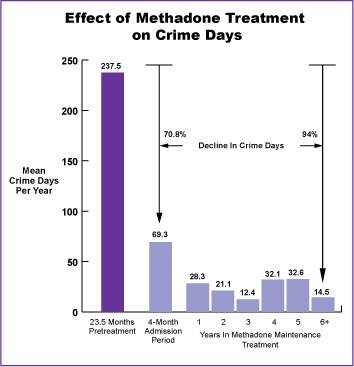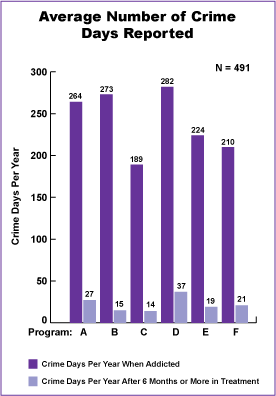Question 4: Does methadone maintenance treatment reduce criminal activity?
Answer: Yes. Patients are less likely to become involved in criminal activity while in methadone maintenance treatment.
- Patients who remain in methadone maintenance treatment for long periods of time are less likely to be involved in criminal activity than patients in treatment for short periods.
- The availability of methadone maintenance treatment in a community is associated with a decrease in that community’s criminal activity, particularly theft.
Research Highlights
- In a meta-analysis of 24 studies, results indicate an overall small-to-medium effect of r = -0.25 (unweighted) of the impact of methadone maintenance on criminal activity. A large effect size of r = 0.70 (unweighted) was seen in those studies that investigated the efficacy of methadone maintenance treatment in reducing drug-related criminal behaviors. A small-to-moderate effect of r = 0.23 (unweighted) was obtained when both drug and property-related criminal activities were evaluated. Finally, a small effect of r = 0.17 (unweighted) was demonstrated when drug- and nondrug-related criminal behaviors were combined (Marsch, 1998).
- In the Treatment Outcome Perspective Study (TOPS), 32 percent of the methadone maintenance patients acknowledged committing one or more predatory crimes in the year before treatment, but only 10 percent continued these activities during treatment. By 3 to 5 years after leaving treatment, only 16 percent of the patients reported predatory criminal activity–a reduction of one-half the pretreatment level (Hubbard, Marsden, Rachal, et al., 1989).
- Among the 617 patients studied by Ball and Ross (1991), there was a 70.8-percent decline in crime-days within the 4-month methadone maintenance treatment period. This decline was followed by continuing, but less dramatic, declines in mean crime-days among those in treatment for 1 to 3 years. Those in treatment for 6 or more years had the lowest rate of crime-days per year (14.5).
- The Powers and Anglin (1993) retrospective study of 933 heroin addicts demonstrated that rates of criminality, arrests, and drug dealing decreased during episodes of methadone maintenance treatment when compared with addicts not in treatment.
- In the National Treatment Outcome Research Study, acquisitive criminal behavior decreased in the majority of the 333 patients except those (n = 88) who were felt to have a poor treatment response. In these patients, there was no change in this type of criminal activity (Gossop, Marsden, Stewart, et al., 2000).
- The meta-analysis by Mattick, Breen, Kimber, et al. (2003) revealed that criminal activity declined in consort with reductions in heroin use, although the advantage for methadone beyond control in reducing criminal activity was not statistically significant (3 studies, 363 patients: RR = 0.39, 95% CI: 0.12-1.25).
The Effects of Methadone Maintenance Treatment on Crime-Days–Ball and Ross study (1991) of 617 patients demonstrated that methadone maintenance treatment is associated with a dramatic decline in the average number of crime-days per year.

Figure 17 illustrates that the average number of crime-days per year before treatment was 237. During the 4-month initial methadone maintenance treatment, the average number of crime-days per year was 69. This represents about a 71-percent decline. This dramatic decline was followed by continuing, but less dramatic, declines in the average number of crime-days among those in methadone maintenance treatment for 1 to 3 years. Patients who remained in methadone maintenance treatment for 6 or more years reported only 14.5 crime-days per year, representing a 94-percent decline in average number of crime-days (Ball and Ross, 1991).
Crime Before and During Methadone Maintenance Treatment at Six Programs-Ball and Ross (1991) found a dramatic decline in crime when comparing pretreatment crime-days per year and the number of crime-days per year after 6 months or more in methadone maintenance treatment.

Figure 18 illustrates the average number of crime-days reported by patients in six methadone maintenance treatment programs. Although there are differences among programs, the dramatic decrease in crime-days before and during methadone maintenance treatment occurs for all six programs. Crime was reduced by approximately 90 percent in program A, 95 percent in program B, 93 percent in program C, 87 percent in program D, 92 percent in program E, and 90 percent in program F. The average reduction in crime for those in methadone maintenance treatment was just over 91 percent (Ball and Ross, 1991).
The cost benefits of methadone maintenance treatment become obvious when one compares the costs of providing treatment with the social costs that would have occurred if the crime level had continued.
References
Ball JC, Ross A. The Effectiveness of Methadone Maintenance Treatment: Patients, Programs, Services, and Outcomes. New York: Springer-Verlag, 1991.
Gossop M, Marsden J, Stewart D, Rolfe A. Patterns of improvement after methadone treatment: 1 year follow-up results from the National Treatment Outcome Research Study. Drug & Alcohol Dependence 2000;60(3):275-86.
Hubbard RL, Marsden ME, Rachal JV, Harwood HJ, Cavanaugh ER, Ginzburg HM. Drug Abuse Treatment: A National Study of Effectiveness. Chapel Hill: University of North Carolina Press, 1989.
Marsch LA. The efficacy of methadone maintenance interventions in reducing illicit opiate use, HIV risk behavior and criminality: a meta-analysis. Addiction 1998;93(4):515-32.
Mattick RP, Breen C, Kimber J, Davoli M. Methadone maintenance therapy versus no opioid replacement therapy for opioid dependence. The Cochrane Database of Systematic Reviews, Issue 2, 2003.
Powers KI, Anglin MD. Cumulative versus stabilizing effects of methadone maintenance. Evaluation Review1993;17(3):243-70
In This Section
- Certificate Programs
- Methadone Research Web Guide
- Acknowledgments
- Introduction
- Part A
- Part B
- Question 1: Is methadone maintenance treatment effective for opioid addiction?
- Question 2: Does methadone maintenance treatment reduce illicit opioid use?
- Question 3: Does methadone maintenance treatment reduce HIV risk behaviors and the incidence of HIV infection among opioid-depen
- Question 4: Does methadone maintenance treatment reduce criminal activity?
- Question 5: Does methadone maintenance treatment improve the likelihood of obtaining and retaining employment?
- Question 6: What effect can methadone maintenance treatment have on the use of alcohol and other drugs?
- Question 7: What components of methadone maintenance treatment account for reductions in AIDS risk behaviors?
- Question 8: Do risk factors for HIV infection acquisition and transmission differ for women compared with men in methadone maint
- Question 9: Is methadone maintenance treatment effective for women?
- Question 10: Is methadone safe for pregnant women and their infants?
- Question 11: Is it necessary to reduce methadone dose or detoxify women from methadone during pregnancy to protect the f
- Question 12: Is the long-term use of methadone medically safe, and is it well tolerated by patients?
- Question 13: Are there program characteristics associated with the success of methadone maintenance treatment?
- Question 14: Are there patient characteristics associated with the success of methadone maintenance treatment?
- Question 15: Are there cost benefits to methadone maintenance treatment?
- Question 16: What are the retention rates for methadone maintenance treatment?
- Question 17: Is mandated methadone maintenance treatment as effective as voluntary treatment?
- Question 18: What is the role of L-alpha-acetyl-methadol (LAAM)?
- Question 19: How do buprenorphine and methadone compare?
- Question 20: Can methadone and buprenorphine be abused?
- Part C
- Part D
- Methadone Research Web Guide Tutorial
- Questions: Methadone Research Web Guide
- Answers: Methadone Research Web Guide
- Methadone Research Web Guide
- Degree Programs
- Virtual Lectures
- Research Publications
Important Dates
NIDA International Forum
June 14–17, 2013
Online Registration Deadline:
May 6, 2013
FELLOWSHIPS
IAS/NIDA Fellowships
Application Deadline:
February 10, 2013
NIDA International Program Fellowships
Application Deadline:
April 1, 2013
Global Health Program for Fellows and Scholars
Application Deadlines: Vary
GRANTS
Brain Disorders in the Developing World: Research Across the Lifespan
(Non-AIDS)
R01 PAR-11-030and R21 PAR-11-031
Application deadline:
February 14, 2013
MEETINGS
American Association for the Advancement of Science
February 14–18, 2013
Boston, Massachusetts, USA
International Drug Abuse Research Society (IDARS)
April 15–19, 2013
Mexico City, Mexico
2013 International Conference on Global Health: Prevention and Treatment of Substance Abuse and HIV
April 17–19, 2013
Taipei, Taiwan
Yih-Ing Hser, Ph.D.

.png)


